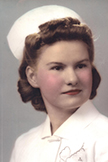

Eleanor Burns Burcky, RN, retired Army second lieutenant, toured Barnes-Jewish College Goldfarb School of Nursing after graduating from its predecessor, the Jewish Hospital School of Nursing, in 1942. Original article was published in BJC Today, vol. 21, no. 23, and posted to BJCnet.
From left are Patrick Burcky, Eleanor Burcky, June Cowell-Oates, EdD, LPC, LCSW, CEAP, Alumni affairs director and program officer, and Martha Stewart, administrative coordinator. | Photo by Libby Coleman
Eleanor Burns Burcky, RN, retired Army second lieutenant, toured the Barnes-Jewish College Goldfarb School of Nursing 76 years after graduating from its predecessor, the Jewish Hospital School of Nursing.
Burky, 98, now lives near Patrick, one of her five children, in Colorado. She returns to St. Louis every year to take in a Cardinals game and visit family, including her sister Agnes.
But this year, she decided to get a look at the successor to the school that set her on a path that would take her around the U.S.
Along with Patrick, she walked the halls, marveling at how nursing had evolved. She was in awe of the simulation lab, where student nurses get hands-on training with lifelike mannequins that can cough, bleed, sit up, run fevers and even deliver a baby.
“We used to have to practice sticking each other in the arms during training,” Burky remarked.
In the ‘nursing home’
Eleanor Burcky, graduation, 1942
Eleanor was the fourth of seven Burns children who grew up in the Walnut Park East neighborhood in north St. Louis. She graduated from Beaumont High School.
She entered the Jewish Hospital School of Nursing on Aug. 31, 1939. At the time, nursing school was a three-year diploma program. The students lived together in a building known among them as “the nursing home.”
Burcky’s class of 36 women graduated from the school in 1942, shortly after the U.S. entered World War II.
Burcky worked for a short time at St. Louis Children’s Hospital. She then settled in to work as an operating room nurse at Jewish Hospital in September 1942.
With the war in full swing, Burcky and many of her friends and co-workers were recruited by the Army to tend to the wounded. So, as a first lieutenant in the U.S. Army, Burcky left to serve her country in Adak, Alaska.
Adak, one of the westernmost Aleutian Islands, was home to the American campaign to drive Japanese troops out of the Aleutians. It also held the 179th Station Hospital.
Burcky’s start on the island was a little rough. She and her best friend, another nurse from St. Louis, arrived in April 1943 by ship together on Adak, but her friend was soon sent to Attu Island. And the nurses’ quarters were very basic, at first. But soon, Burcky was too busy to notice.
Burcky served as a scrub nurse in the operating room and a charge nurse in the orthopedics ward.
Each hospital ward occupied its own Quonset hut, holding 30 patients each. Each nurse was assigned to a ward, assisted by three or four enlisted men. While the nurses cared for patients, the enlisted men did tasks such as bathing patients and changing bed linens.
Since there were few women on Adak, Burcky’s social life was busy, too.
“There was a party going on every night,” she says. “But if I partied every night, I wouldn’t be able to do my job.”
But she was young, she was in a new place, and she was surrounded by people she liked and admired. Being a nurse on Adak was good.
New orders
One day, an Air Force officer flying B-17 missions along the Aleutian Island chain came to the hospital with a severe sore throat. His name was Claude Burcky. They enjoyed each other’s company on Adak.
Then, the war ended, and Eleanor was transferred to California while Claude remained stationed in Alaska. She worked with orthopedic patients at O’Reilly General Hospital and was a scrub nurse at Pasadena Regional Hospital.
On Claude’s next leave, he went to California to see Eleanor, proposed and they were married Dec. 31, 1945, at Fort Richardson Army Base in Anchorage, Alaska.
Eleanor had to wait in Anchorage until Claude got permission for her to join him on Adak. She became the first married woman to be on Adak with her husband. At that time, only one person, husband or wife, could be in the military, so Eleanor left the service and became a full-time housewife. She retired as a second lieutenant on April 19, 1946, with her own VA benefits.
Over the years, the Burckys had five children, born in seven states. As a military family, they were whisked off to a new base about every three years. Some of the places they were stationed included Roswell Air Force Base (AFB), Roswell, New Mexico; Fairchild AFB, Spokane, Washington; Offutt AFB, Omaha, Nebraska; Hickam AFB, Honolulu, Hawaii; Pease AFB, Portsmouth, New Hampshire; and from 1971 to the present, Colorado Springs, Colorado.
Claude Burcky retired from the Air Force as a colonel and died in 2007.
Back in St. Louis
During her Goldfarb tour, Burcky moved a little more slowly than she had in her own student nursing days.
“We were both impressed with all the technology being used, although it was all moving a little fast for mom,” says Patrick.
But to those who accompanied her on the tour, including Goldfarb alumni affairs director June Cowell-Oates and administrative coordinator Martha Stewart, one thing was obvious: After more than 98 years, serving her country, raising a family and traveling around the country, Eleanor Burns Burcky considered nursing one of the most important things she had done in her life.
Follow the Blog via Email
Enter your email address to follow this blog and receive notifications of new posts by email.
Follow the Blog via Email
Enter your email address to follow this blog and receive notifications of new posts by email.

